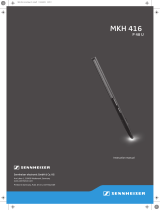
shotgun microphone. This may lead to diffused spatial effects,
which can be desirable or undesirable depending on the re-
cording situation. In case of doubt, the proportion of the S sig-
nal should not be chosen too high. In some cases, it might be
necessary to reduce the treble in the S channel on the mixing
console. At low frequencies below 300 Hz, it is very difficult to
locate sounds for physiological reasons. Since the S system of
the microphone, due to its design principle, is more sensitive
than the M system to low-frequency interference caused for
example by wind, the bass in the S channel should be reduced
if required (eg: with a high-pass filter).
Manufacturer Declarations
Warranty
Sennheiser electronic GmbH & Co. KG gives a warranty of 24
months on these products.
For the current warranty conditions, please visit our website at
www.sennheiser.com or contact your Sennheiser partner.
In compliance with the following requirements
• WEEE Directive (2012/19/EU)
Notes on disposal
The symbol of the crossed-out wheeled bin on the product, the
battery/rechargeable battery (if applicable) and/or the pack-
aging indicates that these products must not be disposed of
with normal household waste, but must be disposed of sep-
arately at the end of their operational lifetime. For packaging
disposal, please observe the legal regulations on waste segre-
gation applicable in your country.
Further information on the recycling of theses products can be
obtained from your municipal administration, from the munici-
pal collection points, or from your Sennheiser partner.
The separate collection of waste electrical and electronic
equipment, batteries/rechargeable batteries (if applicable)
and packagings is used to promote the reuse and recycling
and to prevent negative effects caused by e.g. potentially haz-
ardous substances contained in these products. Herewith you
make an important contribution to the protection of the envi-
ronment and public health.
EU Declaration of conformity
• RoHS Directive (2011/65/EU)
• EMC Directive (2014/30/EU)
The full text of the EU declaration of conformity is available at
the following internet address:
www.sennheiser.com/download










